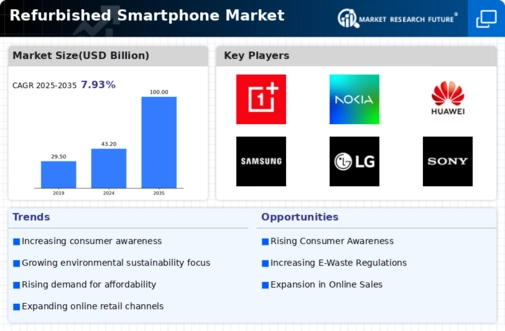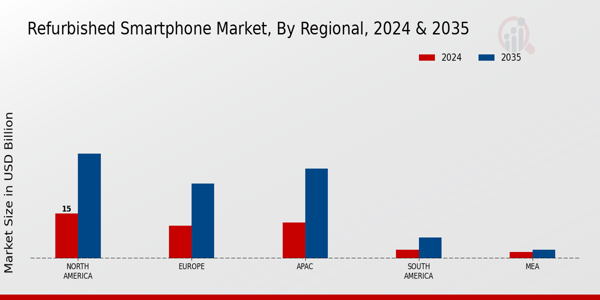Market Growth Projections
The Global Refurbished Smartphone Market Industry is poised for substantial growth, with projections indicating a compound annual growth rate (CAGR) of 7.93% from 2025 to 2035. This growth trajectory reflects increasing consumer demand for affordable and sustainable smartphone options. As the market evolves, it is expected to attract new players and foster innovation within the refurbishment sector. The anticipated market size of 100 USD Billion by 2035 underscores the potential for expansion and the importance of strategic investments in technology and marketing. Stakeholders in the industry must remain agile to capitalize on emerging trends and consumer preferences.
Consumer Acceptance and Awareness
Consumer acceptance and awareness of refurbished smartphones are pivotal drivers in the Global Refurbished Smartphone Market Industry. As consumers become more informed about the benefits of refurbished devices, including cost savings and environmental impact, their willingness to purchase these products increases. Marketing campaigns and educational initiatives play a crucial role in shaping perceptions, highlighting the quality and reliability of refurbished smartphones. This growing acceptance is likely to result in a steady increase in market share, as more consumers opt for refurbished devices over new ones. The industry's ability to effectively communicate these advantages will be essential for sustaining growth.
Growing Demand for Affordable Devices
The Global Refurbished Smartphone Market Industry experiences a surge in demand for affordable devices as consumers seek cost-effective alternatives to new smartphones. With the market projected to reach 43.2 USD Billion in 2024, the appeal of refurbished smartphones lies in their lower price points, which can be up to 50% less than new models. This trend is particularly pronounced in emerging markets where budget constraints drive purchasing decisions. As consumers become more aware of the quality and reliability of refurbished devices, the market is likely to expand, catering to a broader demographic that prioritizes value without compromising on technology.
Environmental Sustainability Initiatives
Increasing awareness of environmental sustainability significantly influences the Global Refurbished Smartphone Market Industry. Consumers are becoming more conscious of electronic waste and the environmental impact of manufacturing new devices. Refurbished smartphones offer a sustainable alternative, reducing the carbon footprint associated with production. This trend aligns with global initiatives aimed at promoting recycling and reducing waste. As a result, companies in the refurbished smartphone sector are likely to capitalize on this growing consumer sentiment, potentially boosting market growth. The industry's commitment to sustainability may also enhance brand loyalty among environmentally conscious consumers, further driving demand.
Rising Smartphone Penetration in Developing Regions
The Global Refurbished Smartphone Market Industry benefits from rising smartphone penetration in developing regions. As smartphone adoption increases, particularly in Asia and Africa, the demand for affordable devices grows correspondingly. Refurbished smartphones serve as an accessible entry point for consumers in these markets, where new devices may be financially out of reach. This trend is expected to contribute to the market's expansion, with projections indicating a growth trajectory that could see the industry reach 100 USD Billion by 2035. The influx of refurbished devices into these regions may also stimulate local economies and enhance digital connectivity.
Technological Advancements in Refurbishment Processes
Technological advancements in refurbishment processes are transforming the Global Refurbished Smartphone Market Industry. Enhanced testing and quality assurance protocols ensure that refurbished devices meet high standards, making them more appealing to consumers. Innovations such as automated diagnostics and repair technologies improve efficiency and reduce costs, allowing companies to offer competitive pricing. As refurbishment processes become more sophisticated, the reliability of refurbished smartphones increases, which may lead to greater consumer trust. This trust is essential for market growth, as it encourages more consumers to consider refurbished options over new devices.















